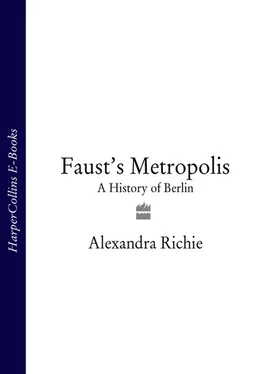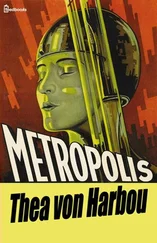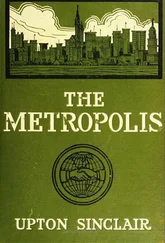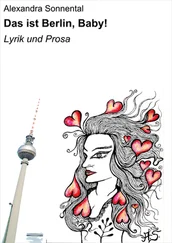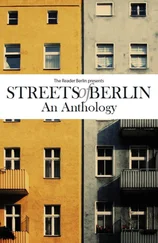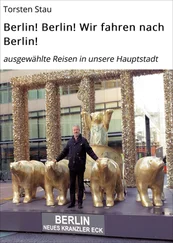The first written evidence of such fortresses dates from the records of a 798 expedition by a Frisian fleet under Charlemagne which made its way up the tributaries of the Havel and saw typical Havellian fortresses there. An even more detailed record is found in one of the most extraordinary travel diaries in the history of central Europe, the eye-witness account written in 970 by the Jewish merchant Ibrahim ibn Ja’quab. Ibrahim was born in Muslim Spain and travelled north as an envoy for the caliph of Córdoba. Like so many masterpieces of the ancient world the diary was saved by an Arab scholar, in this case the eleventh-century Abu Obaid Abdallah al Bekri, who found it so impressive that he reproduced it in his Book of Ways and Lands. Ibrahim ibn Ja’quab’s journey took him along the established trade routes through Prague and probably to Cracow, and then towards Mecklenburg, where it is thought he described the settlement at Schwerin. 26He was struck by the large, secure Slavic fortresses with their high wooden walls strengthened by mounds of packed earth and protected by rivers so that one could only reach them on ‘a wooden bridge over the water’. Evidence shows that even the smaller fortresses at Potsdam, Treptow and Blankenburg were built on islands and were not merely defensive but housed carpenters, weavers, tanners, furriers and other tradesmen. Ibrahim ibn Ja’quab noted that the Slavs ‘are especially energetic in agriculture’. The fortresses also provided a safe haven for the priestly hierarchy who kept the shrines for Dazbag, the god of the sun, Jarovit, the god of spring, and the fertility gods Rod and Rozanicy in their midst. Ibrahim also recognized that the Slavs were skilled merchants and that ‘their trade on land reaches to the Ruthenians and to Constantinople’. The fortresses of Spandau-Burgwall and Köpenick had grown powerful from their position on an important medieval east – west trade route which extended from the Rhine and Flanders through Magdeburg, on to Brennabor, over the Berlin area to Leubus and Posen and on to Kiev. Muslims and Jews were the most influential traders, regularly travelling from China to Africa and up the Caspian Sea and the Volga to the Baltic; trade with the Latin west was maintained primarily by Jewish merchants who, according to the early ninth-century geographer Ibn Khurradadhbeh, were highly sophisticated and could ‘speak Arabic, Persian, Greek, Frankish, Spanish and Slavonic. They travel from west to east and from east to west, by land and sea.’ 27The Jews were not the only merchants to visit the fortresses, however, and although the Slavs themselves used cloth as currency around 1,000 foreign coins of Arabian, German, English, Scandinavian, Polish, Bohemian and Hungarian origin have been found there. Even at this early date Spandau and Köpenick were filled with international dealers: Scandinavian traders had moved in by the ninth century and Arabian and Jewish traders predominated by the year 1000. 28Dozens of products changed hands – from skins, honey, potash, wax, textiles, slate and weapons to jewellery from Kiev and salt from the Rhineland. Slaves were bought and sold; indeed the word ‘Slav’ was first given to the hapless victims captured in the east and then dragged across Europe to be sold in the markets around the Mediterranean. By ad 1000 the Slavs had created prosperous, stable communities on the banks of the Havel and the Spree. Like the Semnonen before them they might well have become the founders of modern Berlin. But Europe was about to undergo another herculean change. This time people would move in from the west. These warriors and settlers would be Christian.
The spread of Christianity was one of the definitive movements in the creation of modern Europe. The advance began within the bounds of the Roman Empire during the first centuries ad; the first bishoprics were established in northern Europe by the fourth century – the bishop of Rheims, for example, was first mentioned in 314 – a process accelerated by the conversion of the legendary Frankish king Clovis. 29For those outside the empire conversion was often brought about by force, and one of the most successful of these Christian warriors, the man who essentially created the Holy Roman Empire, was called Charles the Great or Charlemagne. 30
Charlemagne was born in 742 and became king of the Frankish realm in 768. He was determined not only to resurrect the glory of Rome but to expand its boundaries, to spread Christianity as far as possible and to convert or eradicate the Saxon heathens. After establishing himself in his mighty castle at Aachen he spearheaded a campaign which would take him far into Germany. For eighteen years he waged a bloody war against the Saxons, putting down resistance and massacring those who opposed change. After the battle at Verden in the 782 war he had 4,500 Saxon hostages beheaded in cold blood. 31Not surprisingly, Saxon resistance was crushed by 804 and Charlemagne’s became the first imperial army to reach the river Elbe since Augustus. In 800 he was confident enough to proclaim himself imperator et augustus , the ancient title of the victorious empire, and he was crowned in St Peter’s Basilica by the pope in a dramatic ceremony on Christmas Day.
Despite his ferocity on the battlefield Charlemagne proved himself an admirable administrator, sponsoring the arts and education and dividing the conquered territory into administrative regions called Marken (marches), which were governed by loyal counts or dukes known as Markgrafen or margraves. Charlemagne also favoured the establishment of bishoprics in the conquered lands and made Hamburg the first diocesan seat east of the Elbe. In the end Charlemagne created a new boundary down the centre of Europe called the Limes Sorabicus or Sorbian Wall, which effectively separated Christians from the heathen. It ran from Regensburg through Erfurt, and along the Elbe to Kiel. Berlin still lay a hundred miles beyond the border but Christianity was drawing ever closer. The nearest outpost was a settlement founded on the Elbe. It was called Magdeburg.
The first thing one sees when journeying towards Magdeburg is the great cathedral which rises up from the centre of the small city, its great spires dwarfing everything else around. The building is a mere hint of the city’s role as a beacon on the edge of the Christian world, a stronghold which once lay between ‘Europe’ and the wilderness. Like Trier under the Romans and like West Berlin during the Cold War Magdeburg became a splendid showcase meant both to dazzle and intimidate the poor pagans to the east. The cathedral itself, which started as a small Romanesque church, was regarded as so important that it was endowed by the English king Alfred the Great’s grand-daughter with eighteen casks of gold. Even in its earliest incarnation, it served as a base for missionaries determined to convert the unenlightened Slavs to the east.
Magdeburg continued to be a frontier post under Charlemagne’s successors but it was not until the reign of Henry the Fowler, who ruled from 919 to 936, that a fresh attempt was made to push the borders of Christianity eastward. Like his son Otto I, Henry believed that Magdeburg should be a metropolitan see ‘for all the people of the Slavs beyond the Elbe and the Saale, lately converted and to be converted to God’, and from his palace in the Harz mountains he ordered the creation of bishoprics at Havelberg and the foundation of Quedlinburg and Merseburg. 32The desire to create new strongholds was not simply the result of religious zeal; Henry and his contemporaries felt – quite legitimately – that Christian Europe was under constant threat and that such outposts were essential to its defence. In 845 the Norsemen had decimated the newly founded town of Hamburg and in 875 wiped out a great Saxon and Thuringian army on the Lüneburg Heath while the Magyars from Hungary, the ‘scourge of Europe’, attacked regularly and fought their way as far north as Bremen. 25The new church settlements were built not only as religious centres but also as fortresses to protect the duchy of Saxony against the Hungarians. When Henry died in 936 his son Otto I, who reigned until 973, was determined to continue in his father’s footsteps and expand eastward. This was evident in the ceremony of his investiture as duke of Saxony: ‘I bring before you Otto, chosen by God, designated by Henry, formerly lord of the kingdom, and now made king by all the princes,’ boomed the archbishop of Mainz. ‘Accept this sword with which you are to eject all the enemies of Christ, barbarians and bad Christians. For all power over the whole empire of the Franks has been given to you by divine authority, so as to assure the peace of all Christians.’ 33
Читать дальше
